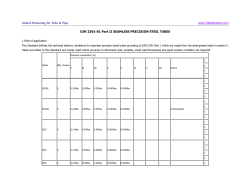
Composite Motorcycle Frame
Composite Motorcycle Frame Dave Brimley, Jose Ramirez, North Parker, Dr. Daniel Adams, Dr. K. L. DeVries Department of Mechanical Engineering Introduction As gas prices rise over the years, people will start looking for new modes of transportation. One of the sectors in the transportation industry that is expected to grow is the use of motorcycles for urban transportation. Our proposal to meet the expected increase in demand is to build a composite motorcycle frame designed for the specific needs of everyday commuters. By building the frame from carbon fiber we will not only reduce the weight, but improve the overall efficiency of the motorcycle while still making it look appealing to the customer. Final Prototype Solutions Steel Joint Test Steel tube test yielded favorable results to justify the use of steel joints instead of a carbon fiber joint construction. After careful calculations a final wall thickness for the steel tube joints was chosen at 0.07 inches to provide a balance between strength and light weight construction. The test proved that the welded joint was incredibly strong and would provide an ample safety factor. Manufacturing Requirements l Built solely for commuter purposes l Designed for loads encountered on a daily commute l Ultra-light carbon fiber tube construction l Aesthetically pleasing design First Prototype Tube and Joint Creation Test Results Carbon Fiber Tests The first prototype consisted of an all carbon fiber construction that would’ve been ideal but poor joint performance (strength) due to manufacturing constraints and inconsistencies, a new joint method had to be devised to meet the strength requirements of the joint. Advanced Composites, Inc. (ACI) was incredibly generous, donating carbon fiber material and the use of their equipment and facility. We were able to fabricate the carbon fiber tubes on their CNC filament winding machine. This ensured consistent tube properties. They allowed us to use other machines in the shop to machine and cut the tubing for the mitered joints. Coped and mitered joints were constructed at different angles and configurations to match each required joint in the frame design. The tubes and steel joints are joined together using a high temperature adhesive with a high strength that provides a joint separation strength that is greater than the yield of either the steel or carbon tube by itself. Alignment and Construction Testing There were several tests conducted to compare the performance of the prototypes related to the predicted metrics defined using Finite Element Analysis (FEA) and ideal manufacturing. A frame alignment jig was fabricated to ensure the fitment of the donor motorcycle components. Steel Joint Test Conclusion Tests were performed on the carbon fiber joint and the steel joints using an Instron testing machine to acquire strength properties from these joints l Mass production of a frame comparable to ours would require extensive research, testing and a large investment. l Molds and other methods for joining tubes together would have to be developed to ensure an accurate and consistent bonding between parts. l Due to our time constraints and available resources we had to build the frame using steel joints that complemented our carbon fiber tubes. l Only one frame was produced and no further materials testing was performed. l Composite frame weight: 14.2 lbs l OEM Kawasaki donor frame: 28.0 lbs l 49.3% weight reduction Problems ACKNOWLEDGEMENTS l Hand made tubes took a substantial amount of time to manufacture. l Heat tape pressure was inconsistent around the joints and thus led to voids and material inconsistencies. l Heat tape was difficult to release and had to be ground off of tubes. l Advanced Composites, Inc. l The Kitten Factory l Dr. Daniel Adams l Dr. K. L. DeVries
© Copyright 2025











